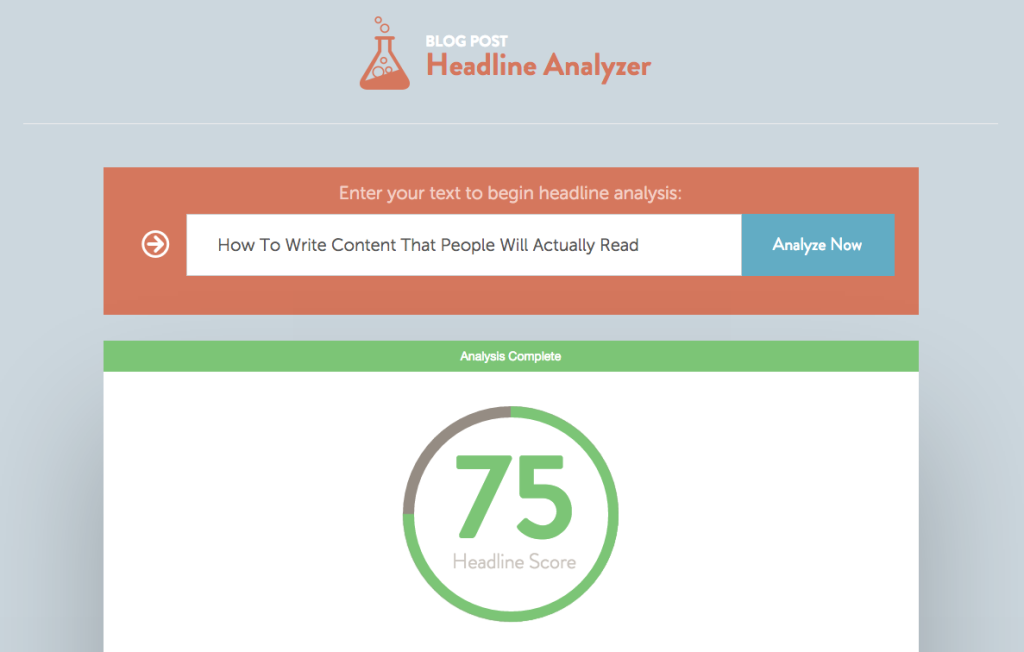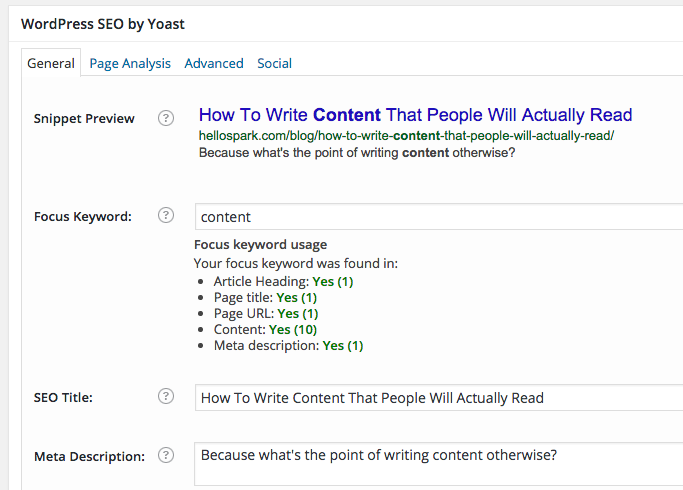Great content is created by getting to know your audience and connecting with them on a personal level. Understanding your audience is crucial – if you don’t, then you’re just wasting your time.
In the following step-by-step guide, I’ll show you how to become a more strategic writer and get your content seen by the right people. On the way, we’ll take a look at some proven tactics that will help you see things from your audience’s perspective and build high impact campaigns.
Step 1: Start With A Compelling Headline
Just like a Drake song, every great article starts with a solid hook. Your headline needs to intrigue readers right off the bat while also letting them know exactly what your article is going to cover.
To figure out how effective my headlines are, I usually come up with a few ideas and then run them through the CoSchedule Headline Analyzer. By drawing on their huge content database, CoSchedule’s tool is able to perform an in-depth analysis of potential headlines and let you know exactly why they do (or don’t) work.
After running some options through there, you’ll come out with a streamlined title that has a pretty good chance of hooking your readers and getting them to give your post a look.
Step 2: Do Your Research
Right away, it’s pretty clear to readers whether you’ve actually researched your blog topic or not (and that’s especially true if you’re trying to target industry experts). Do yourself a favour and put aside the time to learn about the subject that you’re covering – your blog post will be better for it and you’ll come away from the experience a smarter person! Win/win.
Putting in research time doesn’t just mean becoming an expert, it also means paying attention to trends in your industry and popular culture. Incorporating buzzworthy topics is a fantastic way to keep your posts engaging, timely, and interesting while also showing that you understand your audience.
You also need to do research to pin down your audience’s interests. One of the easiest ways to find out what your audience wants to know is by simply reaching out to them and asking them about their experience with your product. By using online survey tools like Qualaroo or shooting your customers a good old-fashioned email, you can get some real insights into their pain points and what kind of things your posts should be covering.
Another cool (and kinda sneaky) way to get some more information about current and potential customers is by checking out sites and forums that they frequent, so that you can get inside their heads. Reddit is one of my favourite tools for this type of research. Just find some Subreddits that are popular with your userbase and start deep diving into threads to find out what kind of questions they’re asking and which topics are important to them.
Now that we have all that sweet, sweet data, let’s start crafting it into a high quality blog post.
Step 3: Be Interesting
Before you start writing, you need to ask yourself a straightforward question: Why should the reader even bother reading my article?
I know it seems obvious, but a lot of people overlook this part of the writing process. What makes you interesting? What makes you different? You need to think about what you bring to the table that no one else does (or at least, that no one has yet) and run with it.
Be funny. Tell a story. Take a fresh approach to a tried and true topic. Whatever it is, just do something to give your blog post that extra boost. This is especially true if you’re trying to reach industry experts: they’ve read all of these articles 1000 times before, so have mercy on them and give them something interesting to read.
Also, you should never underestimate the appeal that some humanizing touches can bring to an article. No one wants to read an article written by a robot – well, not at the moment at least. I think the young marketing god Scott Stratten said it best when he dropped this piece of knowledge:
“If you want to persuade people and get them to pass something around, evoke their emotion.” – Scott Stratten (President, UnMarketing)
Don’t forget that everyone in your audience is human just like you and sometimes we just need a little emotion in our lives. Throw on some R&B, light a couple candles, and get in touch with your real feelings while you write. Or not. Whatever works for you.
Step 4: Don’t Sell, Provide Value Instead
Let’s face it: no one likes being sold to and being too pushy is one of the biggest mistakes that marketers can make. Consumers need to get to know you first before they can just start making it rain all up in here; they need to trust you and believe that they’re going to get some value in return for handing over their hard-earned cash.
“Always provide value. Value builds trust. Once you have that trust, you have the ability to do some selling.” – Mike Volpe (CMO, Hubspot)
You need to stop thinking about selling yourself and start thinking about educating your audience and giving them some value instead. Think about it this way:
- Forgetting your wallet and asking a stranger to buy you lunch = inappropriate.
- Forgetting your wallet and asking a friend to buy you lunch = appropriate.
Why? Your friend trusts you and they know that you’ll hit them back with some value AKA their money AKA Friend Better Have My Money AKA Hey, Dirty, Baby I Got Your Money.
So take off your salesman hat and put on your professor hat (because both of these professions definitely wear hats) and focus on providing value first and foremost. Your audience will learn to trust you and be way more open to being sold to than if you had just popped up with a sales pitch right away.
Step 5: Get Your Content Seen
Writing a blog post is half the battle – getting your content out there is just as important. This part of the process requires a lot of prep work, but it will pay off in the end. You’ll need to be writing your article with social sharing, organic search, and influencer outreach in mind the whole time (and all three of these areas can play off of each other to make your post go viral).
If you’ve taken the above steps into account, you’ve already done a lot to make your post more suitable for social sharing. Interesting content that tells a story, evokes emotion, and has a great headline is a perfect recipe for a viral post. Make sure you give Twitter shoutouts to the people and businesses that you’ve included in your content. A super simple method that’s also super effective – just the way I like it.
Now that your article is social-friendly, you need to make it search-friendly. Do some research and make sure your post touches on popular keywords. Another quick and painless way to give your post some SEO help (if you’re using WordPress) is installing the Yoast SEO Plugin on your blog. This bad boy makes it easy to fill out titles, meta-descriptions, and keywords as well as drop in custom images for social sharing. Even if you aren’t an SEO expert, you’ll definitely be able to give your post a fighting chance on Google.
One of the most important – and neglected – components of getting your content seen is by doing some Influencer Outreach. There are few things more valuable than getting your blog post cosigned by someone influential in your target audience – whether they’re a blogger, celebrity, or both. It only makes sense that your audience will be more compelled to read something if they see it being tweeted out or posted by someone they trust. References are very powerful tools that can drop your post straight into the slipstream.
Now What?
If you take all these things into account, then you should have one dope blog post on your hands! Still wondering how you can get your content seen by the right people? Let’s talk. I’d love to help you out.






